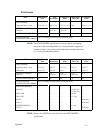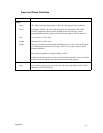Index–1
Index
A
ADDR, 3–7
ASCII Character Set, A–1
ASCII Control Codes by Function
formatting commands, A–10
forms control, A–8
graphic modes, A–7
paper feed, A–9
print quality, A–6
print width, A–5
selecting print modes, A–7
special printer features, A–8
ASCII Dot Patterns, 5–3
B
Bit Image Graphics, 5–8
characteristics of, 5–8
density, 5–11
other features, 5–14
plotting, 5–10
programming format, 5–12
sample program, 5–13
single density sample, 5–13
BS/CR Protocol, A–4
C
Cables
interface, 8–26
reconnecting, 9–8
Centronics Interface, 8–3
characteristics, 8–2
input signals, 8–4
output signals, 8–4
Character Formation, 1–8
Check (CHK), 3–4
Cleaning, 9–5
before, 9–3
external, 9–2
internal, 9–2
requirements, 9–2
Clear Check Condition, B–2
Configuration
change procedure (150B), 4–4
change procedure (MVP/L150), 4–3
methods of configuring, 4–2
verifying changes, 4–5
Configuration Options (150B), 4–6
Auto Line Feed on CR (23), 4–12
Binary Count Slew (25), 4–14
Buffer Print with TOF (44), 4–29
Characters Per Inch in Mode 5 (48), 4–33
Column Print Spacing (56), 4–37
Control Code Assignments (31–41), 4–25
Delete Code 7F (29), 4–18
Double WIde Print Operation (20), 4–9
ESC DC1 Sequence (58), 4–38
EVFU Control (42), 4–27
EVFU Control with no PI (46), 4–31
Forms Length at Power Up (52), 4–36
Inhibit Lowercase/Underline (24), 4–13
Input Buffer Size (57), 4–38
Insert Auto Line Feed (22), 4–11
Line Spacing at Power Up (54), 4–37
LPI Line Spacing (51), 4–35
Mode 4 (45), 4–30
Page Perforation Skip (50), 4–34
Paper Out Delay (27), 4–16
Plotting Exit (43), 4–28
Print or Graphics Mode (30), 4–19
Printer On–line with Power On (26), 4–15
SOH and ETX (47), 4–32


















